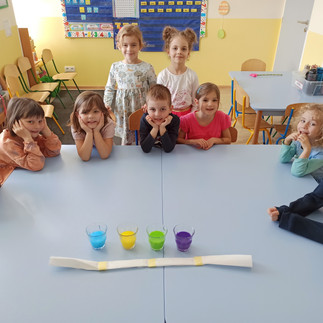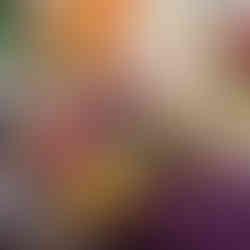Spring 2024 in Benjamin Preschool - Science experiments
- Denisa Kasana
- Apr 14, 2024
- 4 min read
Benjamin Preschool Senec
Tiger and Lion Class
This month the Tiger class did a body tracing activity for science which allowed them to learn about proportions. When learning about our bodies we can learn in many different ways. One way is through art. In this activity we used a large piece of paper to trace one of our classmates. We then observed her face and the human body in general before we talked about her features and parts of her body and face which we used to add detail to her face. The children then got creative and colored-in her body and clothes. This is a great science activity which allows for observation, critical thinking, and of course creativity. We also hypothesized who the shortest student was and determined the results through comparing the outline we’ve traced with our classmates size.
The Lion Class in turn did a ‘Rainbow Skittles Experiment’ which the kids loved. With this experiment the kids learnt about absorption, dissolving and water stratification. The objective was to see how quickly or slowly - depending on the liquid that is poured on the skittles - the colors form a rainbow. The experiment allows you to explore concepts such as solubility, concentration gradients, and the movement of molecules in a liquid medium. It’s a simple and visually appealing way to learn about these scientific principles. By placing a circle of Skittles candies on a plate or in a shallow dish and adding water, the children witnessed the colors from the candy coatings dissolve and create a vibrant pattern.
Bunny Class
During our monthly unit - Books, we took a closer look at them. How do they look, what we can find inside. What are the pages inside the book made of? We've talked about where paper comes from = trees and how important it is for us to recycle paper as many times as we can to save more trees from being cut down.
As part of our sustainability focus at the preschool, we decided to make our own paper. Firstly all of us tear the old, used paper till we did not fill up the big box. We were amazed by the amount of paper there. Our experiment continued by adding the water in the box. All the children were worried that the water would spill. What a surprise for all of us when the water soaks into the paper and the amount of the teared paper decreases in half. We let the paper soak for a few hours.The paper blended easily with the blender with a little bit of water. The kids were thrilled to see the results and feel the mixture. Afterwards we added red ink. Children wanted to have purple as well so they needed to think which color we needed to add to the red paper to get purple. :) They added blue and our purple paper was ready to dry. The next step was to spread the wet paper on a screen to dry. We didn’t have a small screen so we tried an old curtain tighten on the box. Unfortunately it did not work so we placed it on the piece of mat and let it dry for several days. We found out that what helps for the drying process is warm air, therefore we placed the mat close to the radiator. Our own paper is ready, it is not thin as the one from the shop, but it is ours and it is unique.
Ms. Michelle's Kindergarten Class
Water is an essential part of our lives. We need it to survive, regulate our body temperature, carry nutrients throughout our bodies, and provide nourishment. The purpose of the walking water experiment is to teach children how water can flow without the help of external forces. All we needed was four glasses, food colouring, water & some paper towels. Through this experiment the Kindergarten class explored the fascinating world of mixing colours, and simultaneously learnt about capillary action.
We observed how the water moved up the paper towels along with the food colouring molecules, which is due to capillary action. This is the same way that the roots of trees absorb water from the ground. It was an incredibly fun & engaging way to learn about some of the properties of water, as well as how primary colours mix to form new colours.
Benjamin Preschool Pezinok
Ms. Jojka's Class
This experiment is very simple and undemanding in terms of time and materials. For this experiment you will need: twine, toilet roll, tape, balloon, paint or markers. First, we make a rocket out of a paper roll, through which we pass twine. Then we stick the rocket to the balloon and then just let go of the balloon and the rocket flies "into space".
Ms. Dani's Class
Dancing Raisins Experiment
This experiment demonstrates how an object's density can change. At first, the
raisin sinks because its density is greater than the carbonated liquid. Then the
carbon dioxide bubbles stick to all of the little creases of the raisin and increase the raisin's volume. This helps it to displace more liquid and up it goes!
Ms. Suzy's Kindergarten Class
Our science is one long-term experiment! On the first day of spring every child planted his/her own seed, so when the germination and growing turns out successfully, the child can take the plant home to the garden or balcony. First we spoke about the plant life cycle so we explained the terms such as germination, pollination, sprout or seedling. Then we signed our name tag and planted the seed - children could choose among tomato, pea, basil.
Fingers crossed!






































Comments